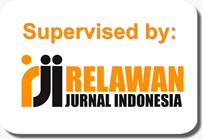ANALISIS ASOSIASI MEREK TERHADAP RESPON KONSUMEN PADA MEREK HEDONIK
Abstract
Keywords: Dimensions brand function, brand extension, recommendation, price premium, hedonic brand
Full Text:
PDFReferences
Aaker, A.D. (1996), “Measuring Brand Equity Across Products And Markets,”California Management Review, Vol. 38, pp. 102-120.
Assael, H. (1998), “Consumer Behavior And Marketing Action”, 6th ed, Cincinnati, Ohio, South-Western College Publishing.
Bele’n del Rio, A., Vasquez, R. and Iglesias, V. (2001), "The effects of brand associations on consumer response,“Journal of Consumer Marketing”, Vol. 18, pp 410-425.
Bhat, S. and Reddy K.S. (1998), “Symbolic and functional positioning of brands,”Journal of Consumer Marketing, Vol. 15, No. 1, pp. 32-43.
Chen, A.0-H. C. (2001), "Using free association to examine the relationship between the characteristics of brand associations and brand equity," Journal of Product & Brand Management, Vol. 10, pp. 439-451.
Cooper, D. R. and Emory, C.W. (1995), "Business Research Methods” Fifth edition, Richard D. Irwin, Inc.
Cooper, D.R. and Schindler, P.S. (2001), Business Research Methods 7th, New York, McGraw-Hill Irwin.
Dhar, R and Wertenbroch, K. (2000), “Consumer choice between hedonic andutilitarian goods,”Journal of Marketing Research, Vol. 37, February, pp.60-71.
Hair, Joseph F., Jr., Rolph E. Anderson, Ronald , Tatham, and William C, Black (1998), “Multivariate Data Analysis” fifth editiomn, Upper Saddle River, NJ: Prentice Hall, Inc.
Keller, L.K. (1993), “Conceptualizing, measuring, and managing customer-based brand equity,”Journal of Marketing, Vol. 57, pp. 1-39.
Kotler, P. (2003), Marketing Management, 11th ed., Upper Saddle River, New Jersey: Prentice hall, Inc.
Lestari, Ika W. (2003), Analisis sikap konsumen terhadap foraign branding pada kategori produk hedonis, utilitarian dan hibrid, Skripsi, FE. UGM, Tidak dipublikasikan.
Masterson, S. S., Lewis. K, Goldman. B.M., and Taylor. M. S. (2000), “Intergrating Justice and Social Exchange: The Differing Effects of Fair Procedures and Treatment on Work Relationships,”Academy of Management Journal. Vol. 43, No.4, pp 738-748.
Rahman, Yasir A. (2000), Pengaruh ekuitas merek pada preferensi merek dan keinginan membeli, Tesis, Program Magister Sains UGM, Tidak dipublikasikan.
Sekaran, U. (2000), Research Methods for Business: A Skill Building Approach, 3th ed., New York, John Wiley & Sons, Inc.
Yuliani, E. (2003), Analisa perbedaan pengaruh fungsi merek terhadap respon konsumen, Tesis, Program Magister Sains UGM, Tidak dipublikasikan.
DOI: https://doi.org/10.31846/jae.v3i3.172
Refbacks
- There are currently no refbacks.

This work is licensed under a Creative Commons Attribution-NonCommercial-NoDerivatives 4.0 International License.
e-Jurnal Apresiasi Ekonnomi Indexed by:












